Ferns and mosses of the Happy Valley Forest
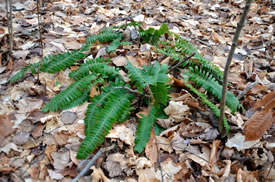
The Christmas fern, green against dead leaves in the fall (Photo by Dr. Henry Barnett)
The Happy Valley Forest is home to a large number of common and uncommon ferns (my daughter Ann Love has records of 18 fern species in this forest area). The Christmas fern is very common in the forest and at its edges. It retains its green...
Reptiles and amphibians of the Happy Valley Forest
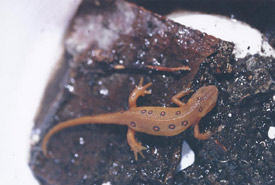
Red eft (the immature form of the spotted newt) are the commonest reptile in the Happy Valley Forest and crowd the forest trails during egg-laying time. (Photo by Dr. Henry Barnett)
The reptile species in the Happy Valley Forest number 19. The area provides one of the last redoubts for the threatened Jefferson’s salamander. Red efts are common, red-backed and spotted salamanders will be regularly seen in the but the...
Mammals of the Happy Valley Forest
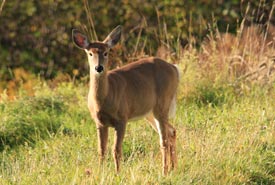
White-tailed deer thrive in Happy Valley Forest wintering in the Hemlock areas of relatively less snow. (Photo by Dean Mullin)
In the wintertime the mammals are the most conspicuous form of life in the forest. The largest is the white-tailed deer, of which as many as nine have appeared below our feeder. Squirrels are the commonest mammal, with the black and its colour...
The day peace was announced
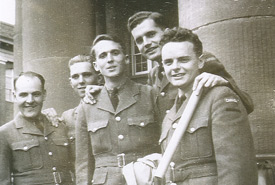
Graduation day June, 1944. Five lieutenants in the RCAMC (left to right: Crawford, LaPierre, Barnett, Wells, and Smyth). Headed for junior internship then army officer training camps, graduating as captains.
I graduated from an abbreviated Toronto medical course in June of 1944. My real interest as a youth was to become an ornithologist but that did not resonate well with my father or the culture of the times. Instead I decided upon medical school and...
Bats of the Happy Valley Forest region
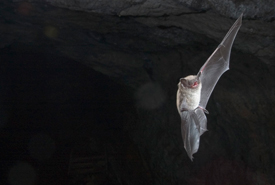
Little brown myotis (Photo by Brock Fenton)
I’ve had many encounters with bats in the Happy Valley Forest over the years, but perhaps the most memorable was the one day in my practicing years when I was asked to visit on elderly lady at home. Consultants tend to eschew house-calls.As...
Birds of the Happy Valley Forest (Part Five)
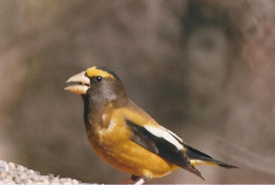
Evening grosbeak (Photo by Anna Tchoulik)
Our forest cover in the Happy Valley begins a few miles above the lakeshore of Lake Ontario. Birds stop here each year to feed and rest while on their migration north in the spring, and as a last stop in the fall as they move south. In the fall...
Birds of the Happy Valley Forest (Part Four)
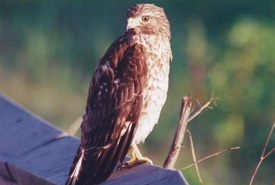
This hawk lives in closed canopies such as those found in Happy Valley and thrives on small mammals and birds. (Photo by Dr. Henry Barnett)
During our five-year participation in Ontario in the Breeding Bird Census, daughter Ann Love and I found 109 breeding species in the Happy Valley Forest area or species seen regularly overhead in breeding season. The Happy Valley Forest has no...
Birds of the Happy Valley Forest (Part Three)
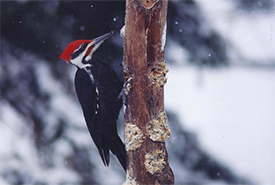
Pileated woodpecker, the size of a small crow, is the glamour boy of the Happy Valley Forest. His shouting call is heard throughout the year. (Photo by Dr. Henry Barnett)
Without a doubt the pileated woodpecker is close to the top of dramatic inhabitants of the Happy Valley Forest. Its demanding call is befitting of the crow-like size and overall rugged appearance — wild! One cannot walk in the forest in the...
Birds of the Happy Valley Forest (Part Two)
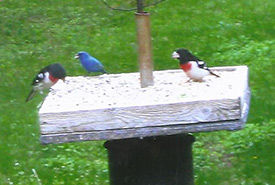
Two species commonly sharing the feeder: rose-breasted grosbeak and male indigo bunting. These and the oriole represent the greatest beauties in the forest. (Photo by Dr. Henry Barnett)
Summer birds There is plenty of sound in the Happy Valley Forest, from the summering birds throughout the day and the woods only quiet down from September to late March. Some usually mid-southern birds have reached the Moraine to live. I can...
Birds of the Happy Valley Forest (Part One)
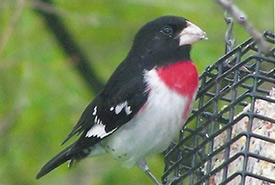
Strikingly beautiful male rose-breasted grosbeak at the feeder eating suet. (Photo by Dr. Henry Barnett)
About 240 species of birds have been recorded over the past 60 years by my observation and that of my family occurring either within or over the Happy Valley Forest. In the first centuries of European occupation of forested Canada there was a...

